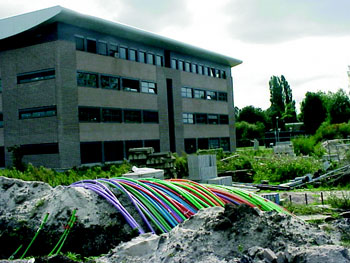|
|||
Advanced Communication Networksby Michel Mandjes The current trend in telecommunications is towards ubiquitous availability of any application - at any time or any place. This will eventually lead to the universal accessibility of a common network infrastructure that supports all imaginable communication services. CWI's researchers are working on the use of queueing theory in communication networking, which is relevant in many areas, including wireless services and network economics research. Application of the developed techniques could lead to a more economic use of network resources. Technological innovations in networking are occurring at a rapid pace. Whereas early networks supported a limited number of communication services, nowadays a broad variety of services are integrated into a single infrastructure. This inevitably leads to performance issues. For instance, a voice user asks for essentially real-time service, in particular minimal delay, whereas these delay requirements are far less demanding when sending an e-mail. While the network could be designed to meet the most stringent of these Quality of Service (QoS) requirements, this would clearly lead to low utilisation, and consequently a waste of resources.
CWI's Advanced Communication Networks theme (PNA2) aims to apply queueing theory to tackle these traffic management problems. Queueing theory is all about congestion effects arising from scarce resources. It helps to understand how congestion arises, but also how congestion can be avoided. In particular, queueing theory facilitates the development of QoS differentiation mechanisms. CWI's research has focused on novel scheduling mechanisms, such as Generalised Processor Sharing (GPS), that are capable of offering multiple QoS levels. A key research issue in this area concerns the protection of user classes against 'misbehaving' traffic streams - in this way GPS mitigates the impact of heavy tails. This strand of research requires sophisticated probabilistic techniques such as large-deviations methods, as well as a thorough knowledge of Gaussian processes. Recent developments in networking have led to challenging new research directions. One important field concerns performance support for wireless services. Current wireless systems like GSM are highly customised for carrying voice traffic, and offer only limited low-bandwidth data applications, such as short messaging services (SMS). The next generation of wireless networks like UMTS are specifically designed to support a wide range of high-speed data applications, such as Web-browsing sessions, document transfers, and imaging services, in addition to conventional voice calls. The integration of these heterogeneous applications raises similar challenges to those described above for wireline systems. However in wireless environments, these issues are further exacerbated by the relatively low bandwidth and scarcity of spectrum (see the UMTS licence auctions), and the propagation characteristics of wireless signals. In particular, the transmission rate in wireless communications fluctuates considerably over time due to multi-path propagation effects. These rate fluctuations provide an opportunity to achieve throughput gains by scheduling data transmissions. Recent research in PNA2 has explored the QoS as perceived by users of such 'channel-aware' or 'opportunistic' scheduling algorithms. It was shown that user-level performance may be evaluated by means of a processor-sharing model with a variable service rate. The variable service rate captures the throughput gains achieved by the channel-aware scheduling algorithms. A second major effort has been invested into network economics research. As argued above, a prerequisite for the support of heterogeneous applications is the ability to offer multiple performance levels. A next step is to decide how these performance levels should be priced. Evidently, with no pricing, or with a simple flat fee, all users would opt for the premium class, disabling performance differentiation. This can be seen in today's Internet: the flat fee does not encourage 'economical use' of resources. The consequence is that the Internet tends to be used by those who are relatively insensitive to congestion, thus pushing away services that require stringent performance guarantees (such as voice users). This cross-disciplinary phenomenon is usually called the 'tragedy of the commons'. A way to prevent this 'tragedy' from happening is by instituting charges. Performance-sensitive users are usually willing to pay more for the service than congestion-indifferent users. Hence by choosing the prices of the different performance levels appropriately, incentives can be given such that only the performance-sensitive users join the premium class. Recent research in PNA2 has focused on this type of problem, with our approach incorporating microeconomic and game-theoretic elements into the queueing framework. Link: Please contact: |
|||



